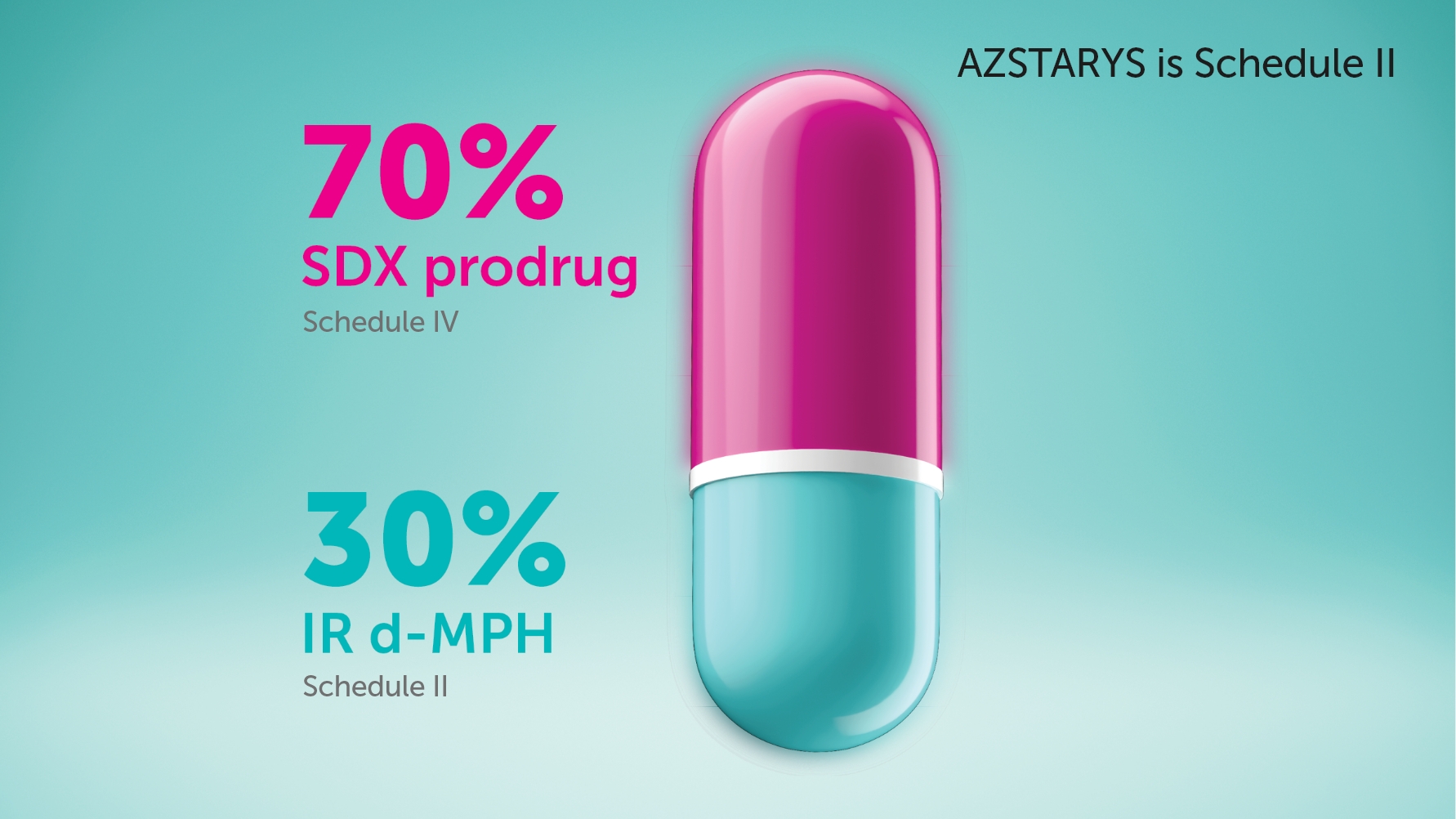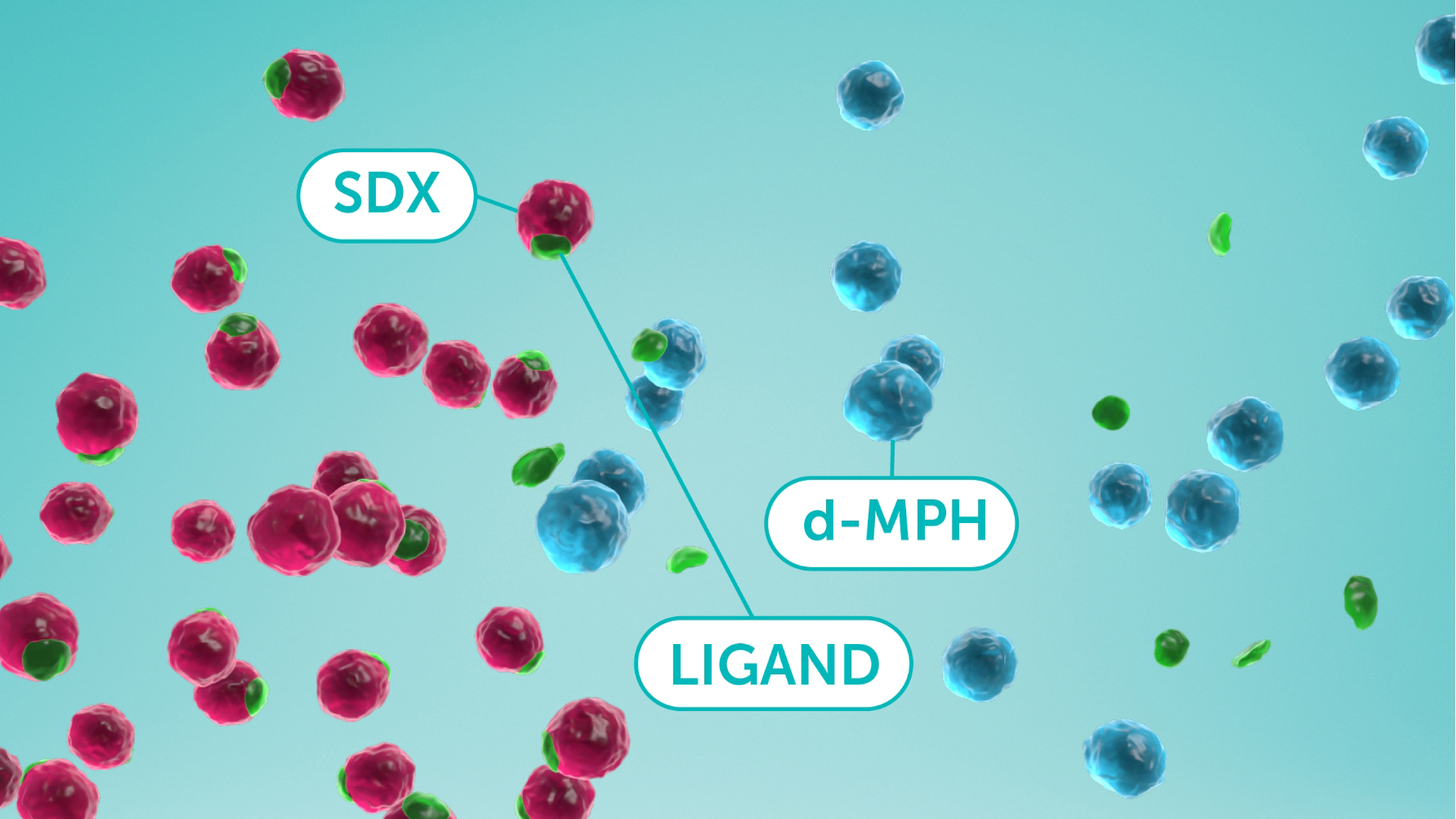- FOR US HEALTHCARE
PROFESSIONALS only - Prescribing
Information - Patient
Site
AZSTARYS® is available for $60 or less for all commercially insured patients—see savings offer for eligible patients.


Each AZSTARYS capsule contains 70% SDX prodrug and 30% IR d‑MPH3

After the ingestion of AZSTARYS, IR d‑MPH is rapidly absorbed.3,4

SDX is gradually converted to d‑MPH through cleavage of the ligand, using the proprietary Ligand Activated Therapy® technology.3,5
All trademarks are property of their respective owners.

Results are from a pharmacokinetics study of AZSTARYS in healthy adults under fasted conditions.3
The clinical relevance of these data has not been established.
aFollowing a single dose of AZSTARYS in healthy adults under fasted conditions.3
ADHD=attention deficit hyperactivity disorder; d-MPH=dexmethylphenidate; IR=immediate-release; SDX=serdexmethylphenidate.
References: 1. Corium, Inc. Corium launches innovative ADHD treatment AZSTARYS™ (serdexmethylphenidate and dexmethylphenidate) in the U.S. for patients age 6 years and older [press release]. July 21, 2021. Accessed May 25, 2023. https://corium.com/pdf/Corium_AZSTARYS_Now_Available_Press_Release_7-21-21.pdf 2. Childress AC, Komolova M, Sallee FR. An update on the pharmacokinetic considerations in the treatment of ADHD with long-acting methylphenidate and amphetamine formulations. Expert Opin Drug Metab Toxicol. 2019;15(11):937-974. 3. AZSTARYS. Prescribing information. Corium, LLC; 2025. 4. Braeckman R, Guenther S, Mickle TC, Barrett AC, Smith A, Oh C. Dose proportionality and steady-state pharmacokinetics of serdexmethylphenidate/dexmethylphenidate, a novel prodrug combination to treat attention-deficit/hyperactivity disorder. J Child Adolesc Psychopharmacol. 2022;32(5):288-295. 5. Patrick KS, Radke JL, Raymond JR, et al. Drug regimen individualization for attention-deficit/hyperactivity disorder: guidance for methylphenidate and dexmethylphenidate formulations. Pharmacotherapy. 2019;39(6):677-688. 6. Kollins SH, Braeckman R, Guenther S, et al. A randomized, controlled laboratory classroom study of serdexmethylphenidate and d-methylphenidate capsules in children with attention-deficit/hyperactivity disorder. J Child Adolesc Psychopharmacol. 2021;31(9):597-609.
AZSTARYS is a central nervous system (CNS) stimulant indicated for the treatment of Attention Deficit Hyperactivity Disorder (ADHD) in patients 6 years and older.
The use of AZSTARYS is not recommended in pediatric patients younger than 6 years of age because they had higher plasma exposure and a higher incidence of adverse reactions (e.g., weight loss) than patients 6 years and older at the same dosage.
WARNING: ABUSE, MISUSE, AND ADDICTION
AZSTARYS has a high potential for abuse and misuse, which can lead to the development of a substance use disorder, including addiction. Misuse and abuse of CNS stimulants, including AZSTARYS, can result in overdose and death and this risk is increased with higher doses or unapproved methods of administration, such as snorting or injection.
Before prescribing AZSTARYS, assess each patient’s risk for abuse, misuse, and addiction. Educate patients and their families about these risks, proper storage of the drug, and proper disposal of any unused drug. Throughout treatment, reassess each patient’s risk and frequently monitor for signs and symptoms of abuse, misuse, and addiction.
Please click here for Full
Prescribing Information,
including Boxed WARNING on Abuse, Misuse, and Addiction.

AZSTARYS is a central nervous system (CNS) stimulant indicated for the treatment of Attention Deficit Hyperactivity Disorder (ADHD) in patients 6 years and older.
The use of AZSTARYS is not recommended in pediatric patients younger than 6 years of age because they had higher plasma exposure and a higher incidence of adverse reactions (e.g., weight loss) than patients 6 years and older at the same dosage.
WARNING: ABUSE, MISUSE, AND ADDICTION
AZSTARYS has a high potential for abuse and misuse, which can lead to the development of a substance use disorder, including addiction. Misuse and abuse of CNS stimulants, including AZSTARYS, can result in overdose and death and this risk is increased with higher doses or unapproved methods of administration, such as snorting or injection.
Before prescribing AZSTARYS, assess each patient’s risk for abuse, misuse, and addiction. Educate patients and their families about these risks, proper storage of the drug, and proper disposal of any unused drug. Throughout treatment, reassess each patient’s risk and frequently monitor for signs and symptoms of abuse, misuse, and addiction.
The site you're about to enter is intended for US healthcare professionals only.
By selecting OK to continue, you confirm you are a healthcare professional.